French top battleship
Ordered in response to both the German Scharnhorst and the Italian Littorio, the Richelieu and jean Bart took up the essence of the previous design, but incorporated a much more powerful machinery to cope with a much higher armor. They definitely draw a line between battlecruisers and battleships.
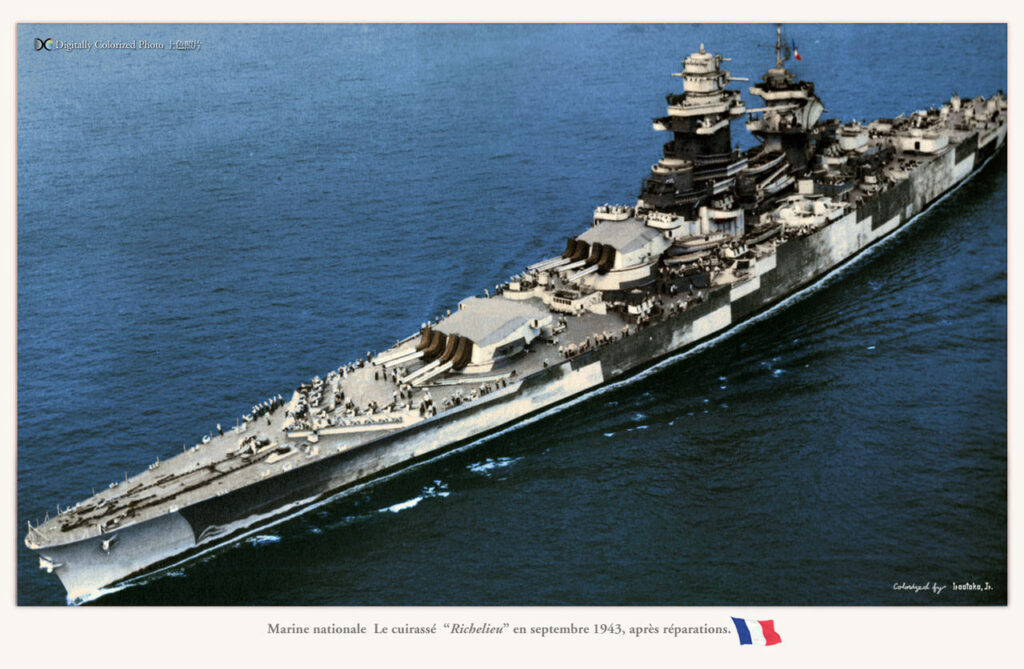
*Cover: Richelieu at sea in 1944 (as seen by the AA on the bridge and dark paint of the bridge). Src: Unknown, retreived from Flickr in May 2018. Colorized by Irootoko Jr.
These were the first true French fast battleships. In addition to their bow cut straight, assuming improved penetration, these also had a unique “mast-funnel”/”mast-stack” or “mack”, a configuration that will be adopted later in the cold war. By concentrating superstructures in the center, as well as turrets, this made it possible to rationalize protection and save tonnage. Therefore the ship was lighter, could meet the standards of the Washington Treaty, but also be faster than many battleships of the day.

Technical Profile of the Richelieu (click to enlarge)
Note: This is a fairly old post and not up to standards. It is scheduled for rewriting in 2024
Design specifics
Armament
The main armament solution chosen was the front two quadruple turrets, just like the previous ships of the Dunkerque class. However, in the classic configuration of two turrets close together, a single hit well placed could have annihilated all the main artillery in one swoop. As a result, those of the Richelieu were quite spaced. The all-front configuration was also inherited from the tactical principle of “crossing the t” of an enemy formation, the attacking ships presenting their bow, presenting the smallest possible silhouette while having all their artillery to bear. On the technical side, the interior division and compartmentation had been studied extensively to minimize the effects of a direct hit and burst of flame, while the main gun mountings were mounted in pairs to save weight and width and also for internal firewalls to be mounted.
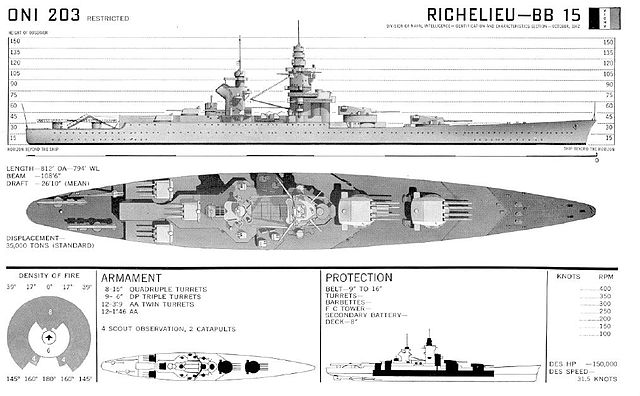
US Navy ONI recoignition plate of the Richelieu, 1943
The secondary armament included triple turrets at the rear, armed with semi-automated, fast-firing, 152 mm pieces. Their high incidence made them effective pieces AA artillery pieces, but their specific fire control system was never installed in time. The secondary AA array, most effective against planes, was on the other hand still weak (even by 1940 standards), not to mention the tertiary AA, composed only of heavy machine guns, in simple and quadruple mountings. Only the twin 37 mm mouts proved to be effective, but they were too few. This kind of AA configuration, which then existed nearly everywhere (at the time of Pearl Harbor, the main anti-aircraft armament of the US Navy rested on 3-in guns (75 mm) and 12.7 mm mounts), was very quickly deemed ineffective against planes flying low at 400 kph and more.
Plans Gallery
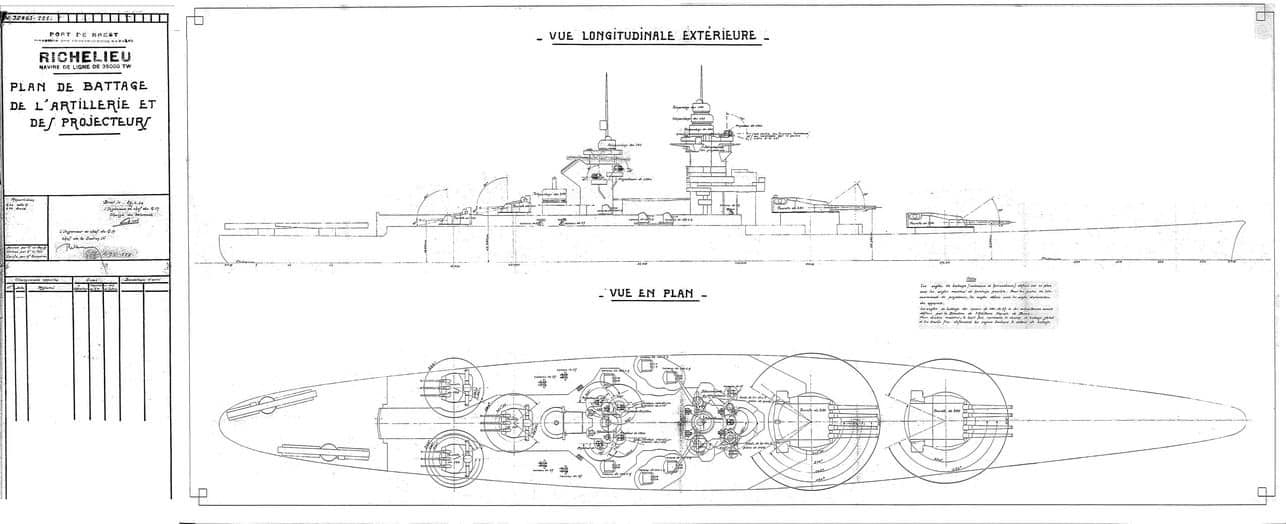
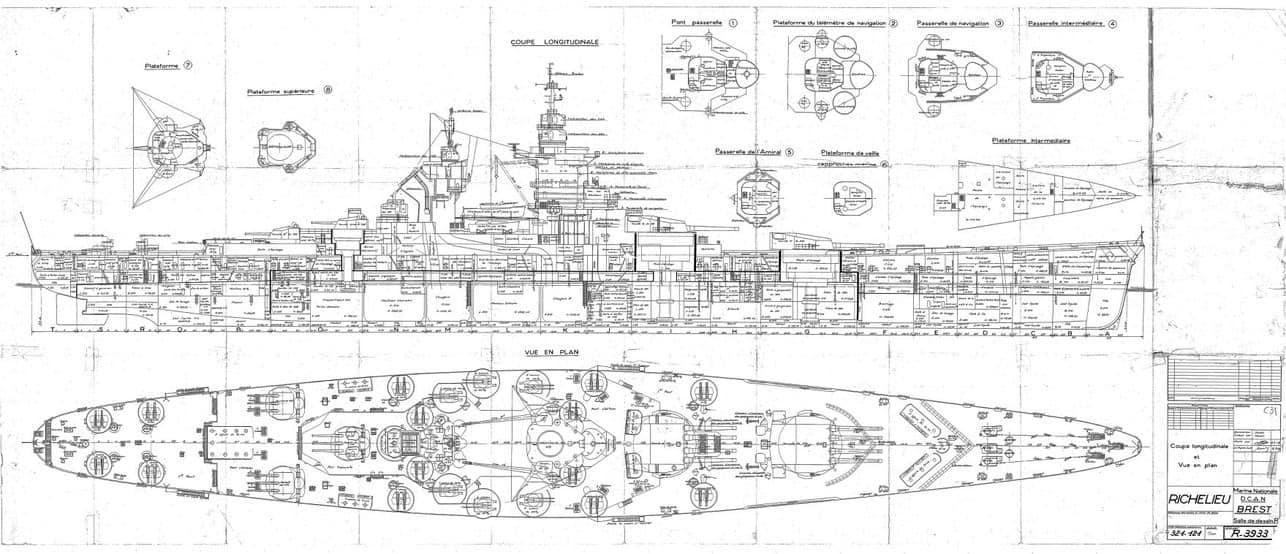



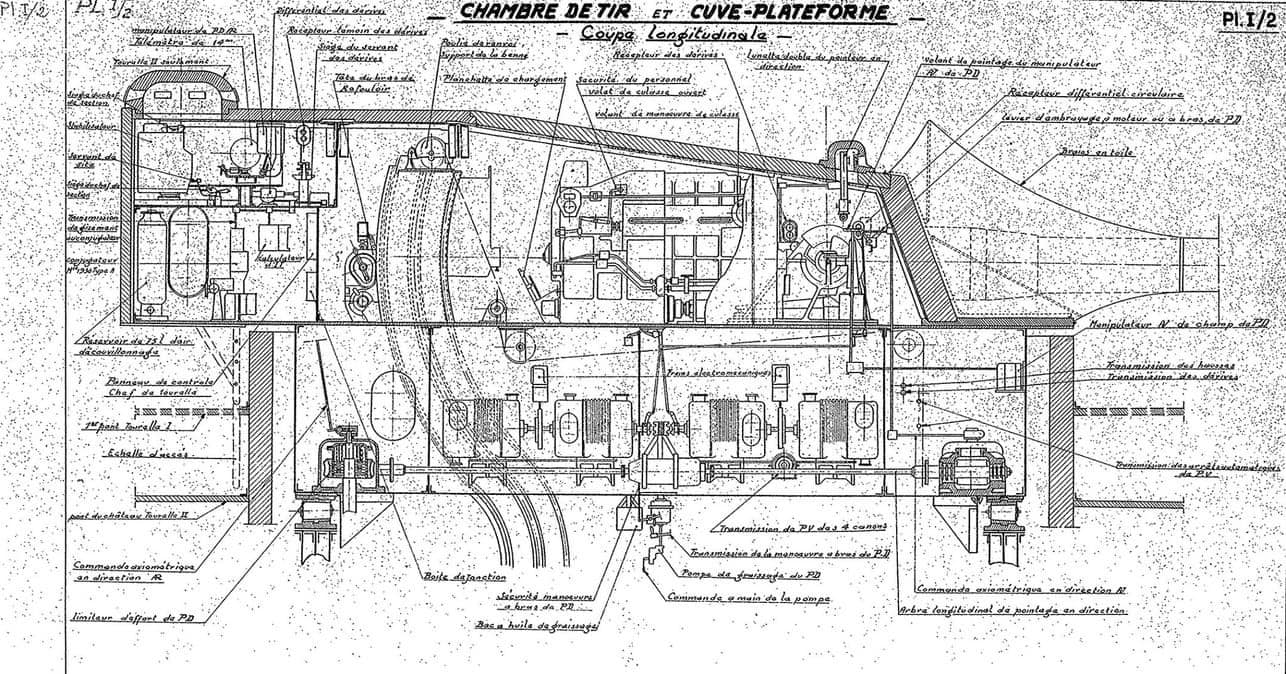
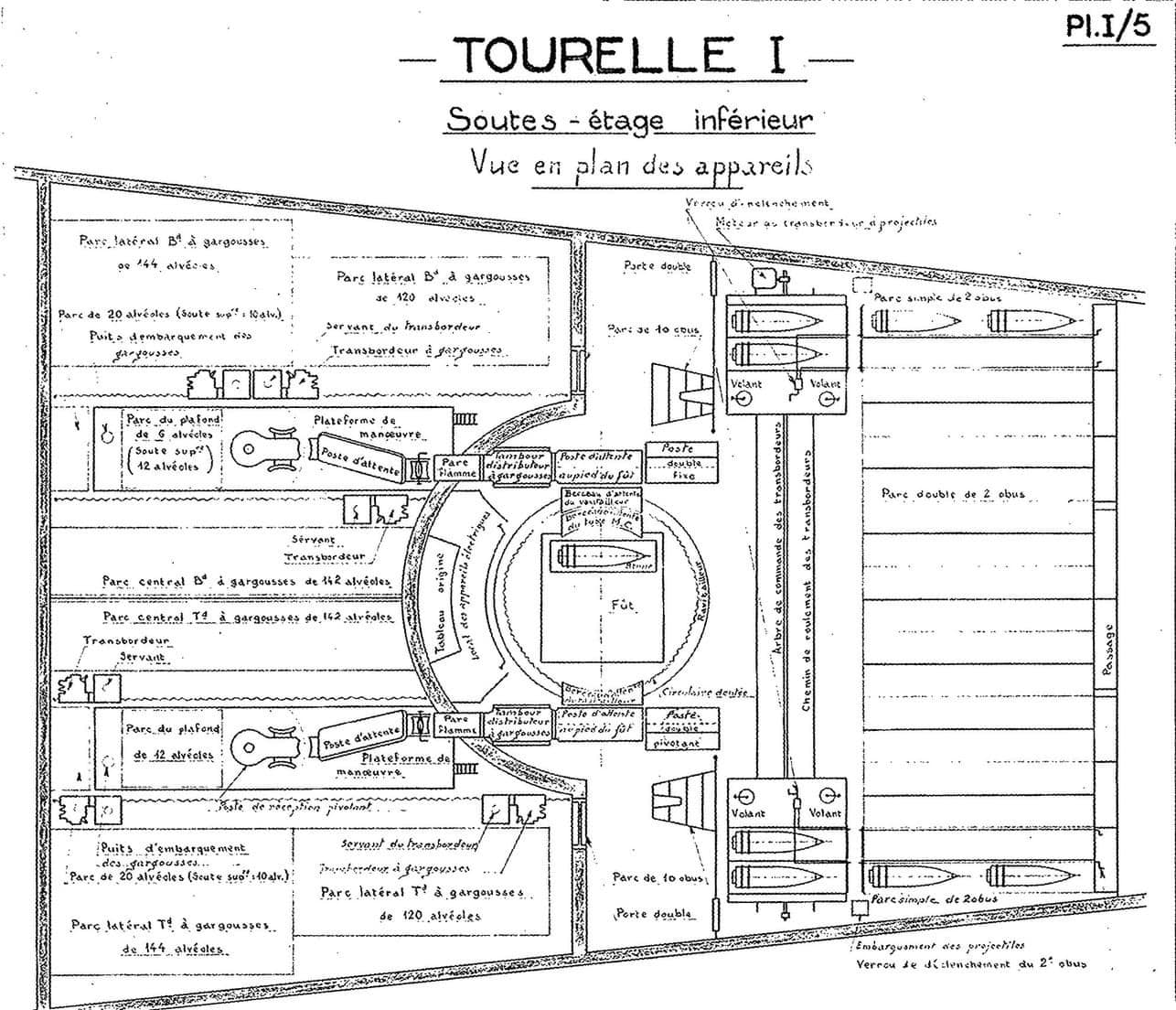
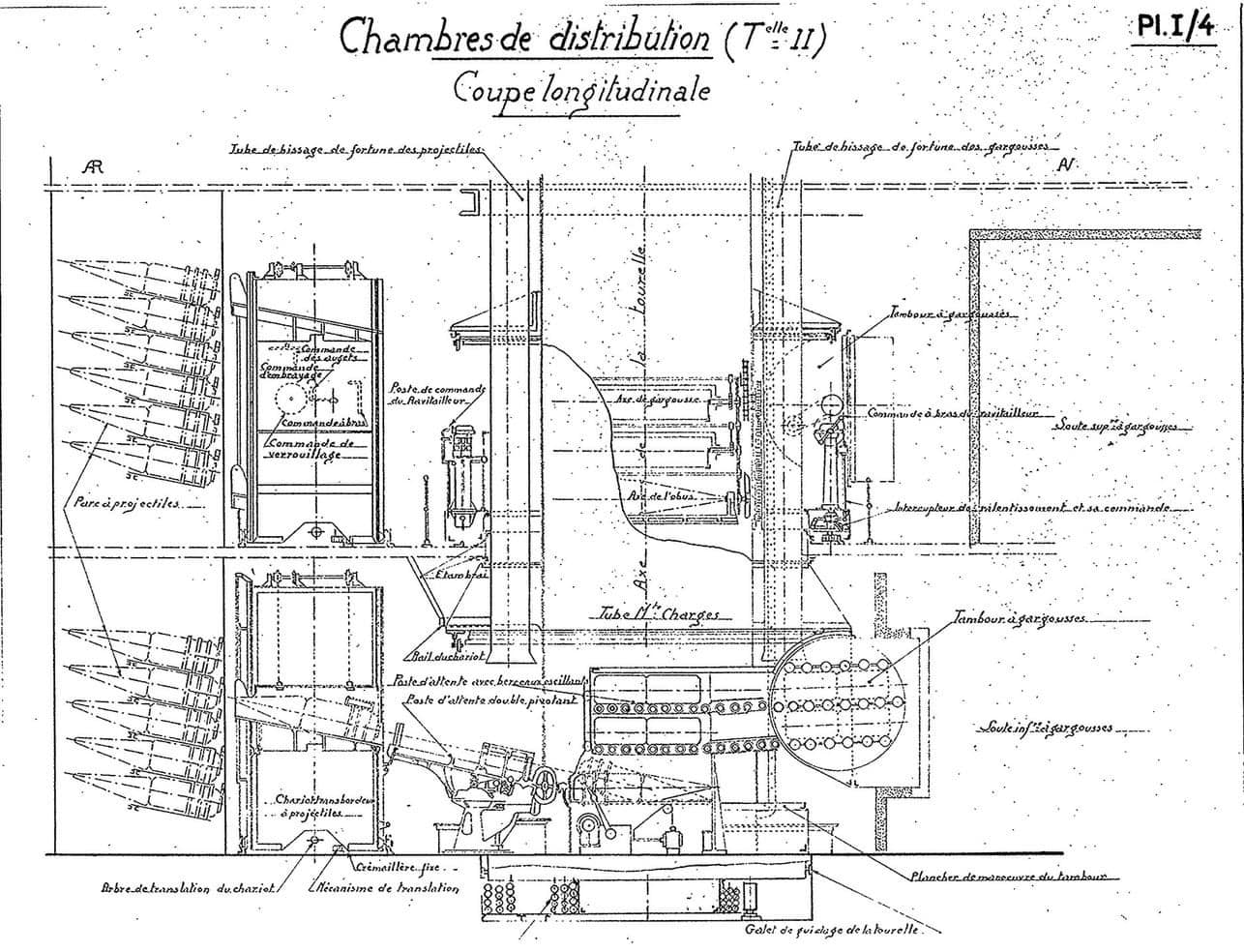
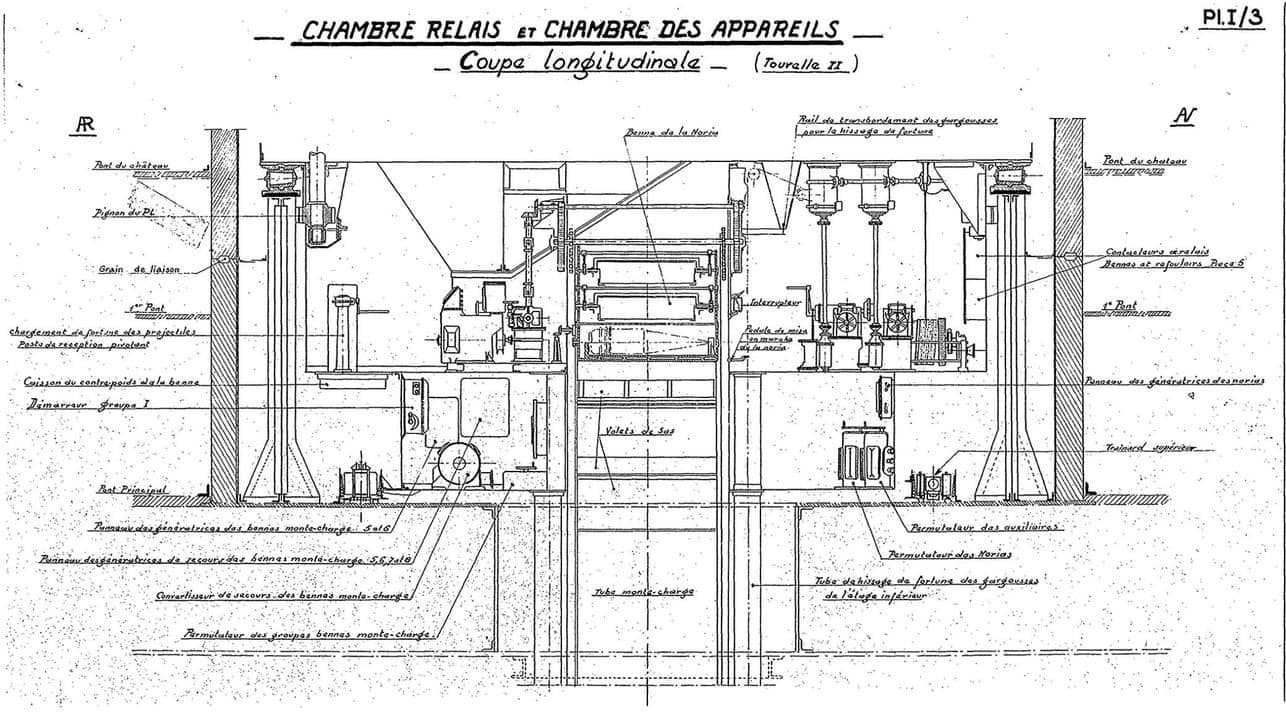
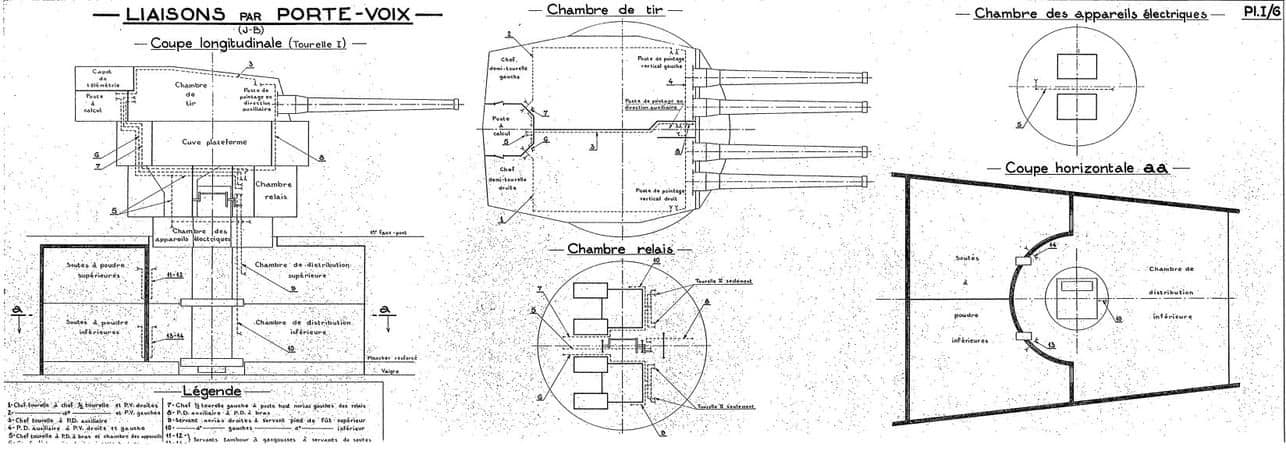

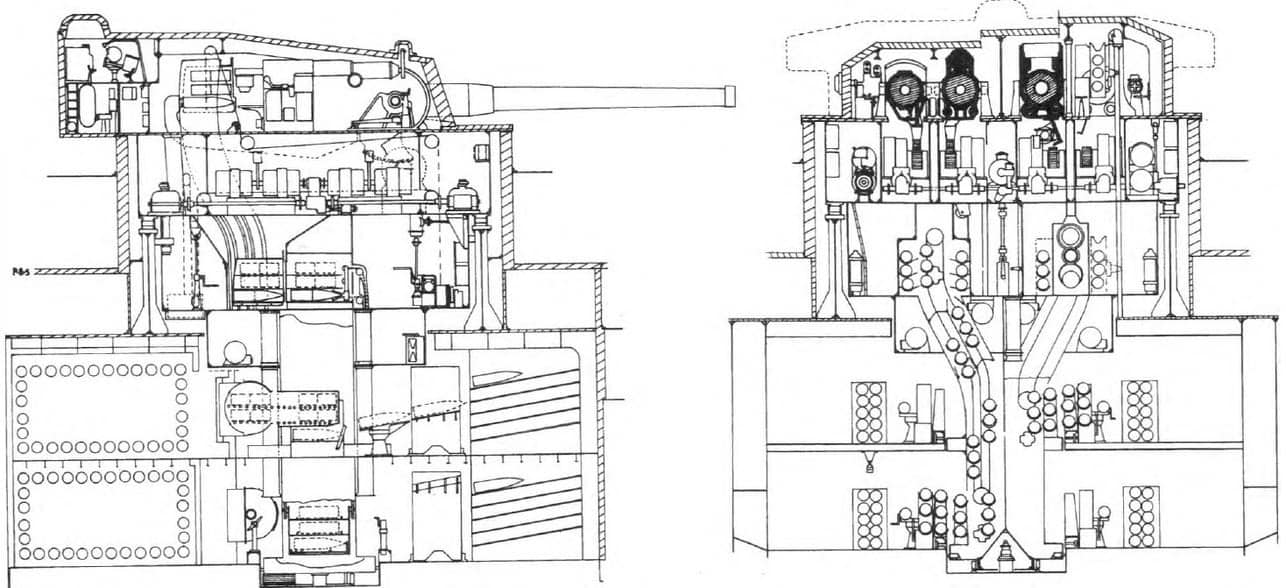
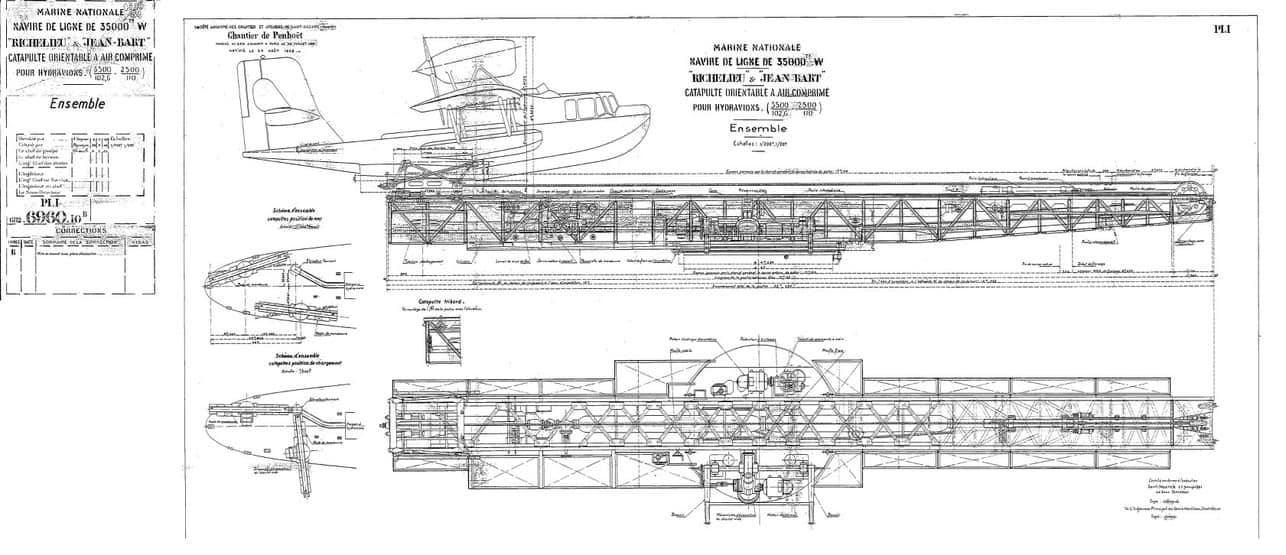


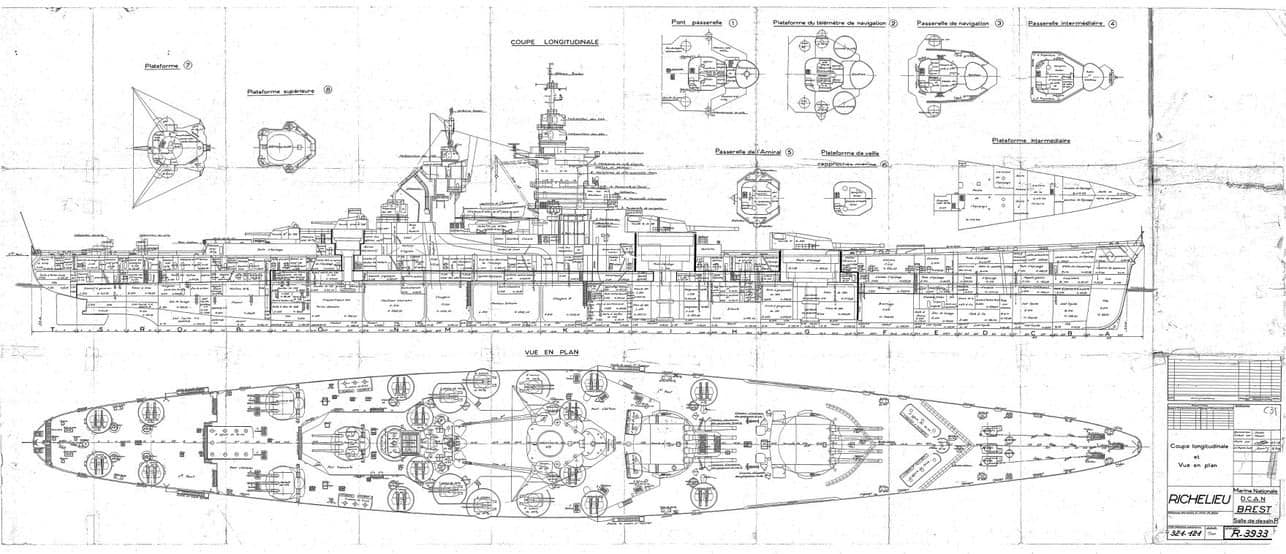
Original archive plans of the French Navy about the Richelieu class
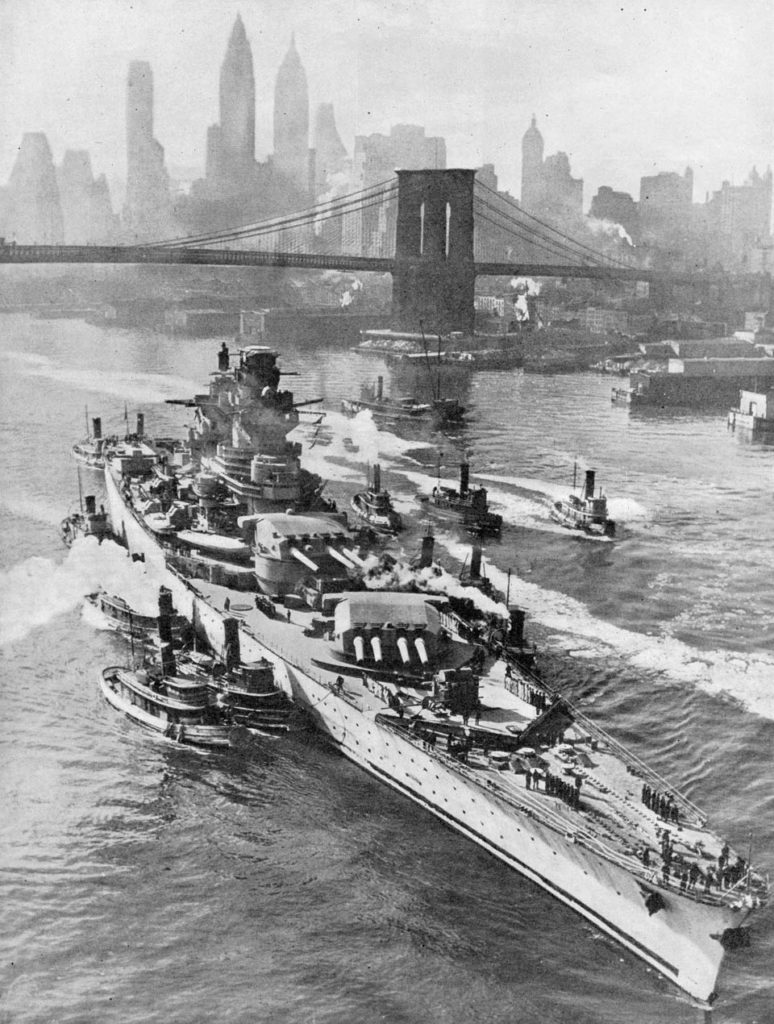
The Richelieu in New York harbour, 1943, Maneuvered by tugboats up New York’s East River. Library of Congress. PD (cc)
Richelieu rearmament 1943
The reconfiguration of the Richelieu in 1943 was therefore entirely based on the standards of the US Navy and the ships received many standards equipment, most notably a large AAA comprising the standards single 20 mm Oerlikon shielded mounts and quadruple 40 mm banks. This combination showed its effectiveness, especially during the Pacific War. Shortly after the start of construction, the Italian Littorio were well advanced, and the Italian Government announced the construction of a third sister-ships, albeit modified, the Vittorio Veneto. As a result in 1938, France voted for the construction of two sister ships of the Richelieu, the Gascogne class. These ships were virtually identical, except that their main armament was distributed this time between the front and rear. They would remain on paper only.
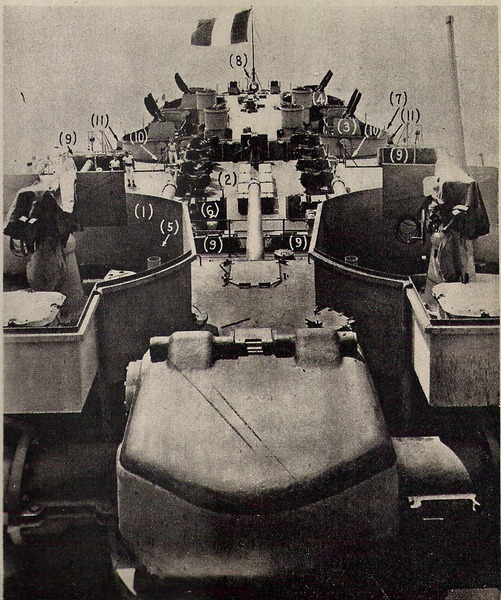
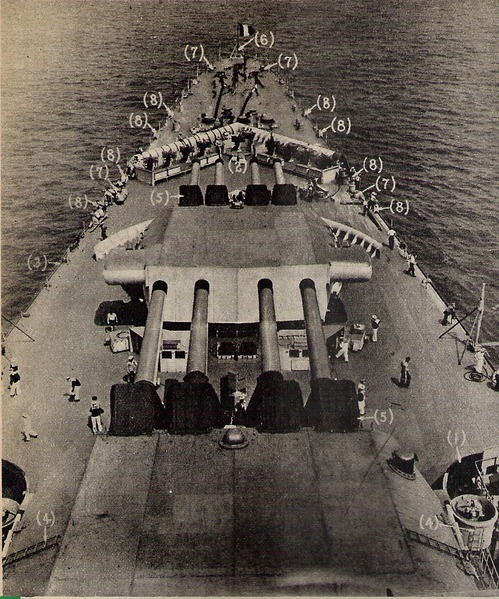
Front and rear deck view of the Richelieu after her 1943 New York refit. Shipbuilder’s Photos, USN, now PD.
Richelieu in action:
The battleship Richelieu was launched in January 1939, therefore she was not ready in June 1940 (95% completion) when invading German Forces aimed at the ports of the coast. Richelieu’s trials had already took place in April. So she left Brest naval Yard before the German advance, with just a small provision of shells for her artillery, just enough fuel oil to reach Dakar and a skeletic crew.
After a true odyssey she reached the African west coast city on June 23 in with her escort of destroyers. After returning to Casablanca at the time of the armistice, the ship want back to Dakar, by then making allegiance to the Vichy regime. During the Operation Catapult in July, after an ultimatum was issued by HMS Hermes, a squad of Royal Marine Commandos in a fast motor boat tried to damage the ship with depht charges, but failed, prompting the release of Fairey Swordfish torpedo planes to finish off the job.
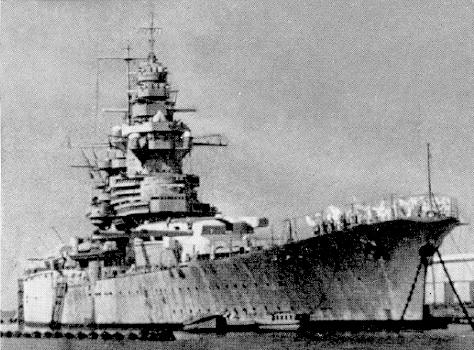
Richelieu in Dakar, 1940 – ONI203 booklet for identification of ships of the French Navy, Nov. 1942
These “stringbags” actually managed to sink the Richelieu partially (the drowned compartments caused the keel to partially lay on the bottom). After some rough repairs and the water pumped, the ship was towed to a remote part of Dakar harbor. She was later joined by the cruisers Georges Leygues and Montcalm. On September 24, a British force raided Dakar once more, but this time with Free French troops led by De Gaulle.
Their hope was to make capitulate the French ubwilling to fire on their own, and make these ship transferred to the Free French Navy. But it was another failure, the Vichy French garrison stubbornly resisting. In the course of 1941, the Richelieu was completely repaired and her fitting-outs completed. In particular, she received additional AAA. She was fitted with a radar and her naval aviation (Loire 130 seaplanes) was disposed, as well as hangars, catapults and equipment completely removed to free the rear deck for more AAA. After Operation Torch and Admiral Darlan’s swap, the fleet moved to the Allied side.
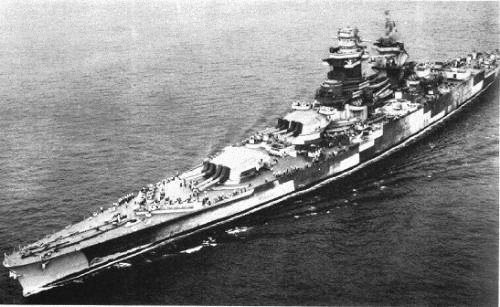
Battleship Richelieu in 1943 – Official U.S. Navy photograph after refit.
The Richelieu left Dakar in January 1943 to reach Puget Sund in New York. She came under a massive re-equipment to American standards, completed in October 1943. She received among others no less than 48 single mounts of 20 mm and 14 quadruple 40 mm mounts. In November 1943, the Richelieu sailed across the Atlantic and joined Scapa Flow where became part of the Home Fleet. She participated in convoy escort missions, including to Murmansk.
In April 1944, she joined the Trincomanlee squadron in the Far East, to be integrated into Task Force 65, actively participating in Operation Cockpit against Sabang and Operation Transom against Surabaya, then Operation Concillor and Pedal in June 1944, and finally Operation Crimson against Sumatra.
Along with battleship HMS Howe, the Richelieu sailed back for Toulon, then Casablanca, and finally Gibraltar, for refit in October 1944. In March 1945, the French battleship was back again in Trincomanlee, participating in a second operation against Sabang and the Nicobar islands with the Task Force 63.
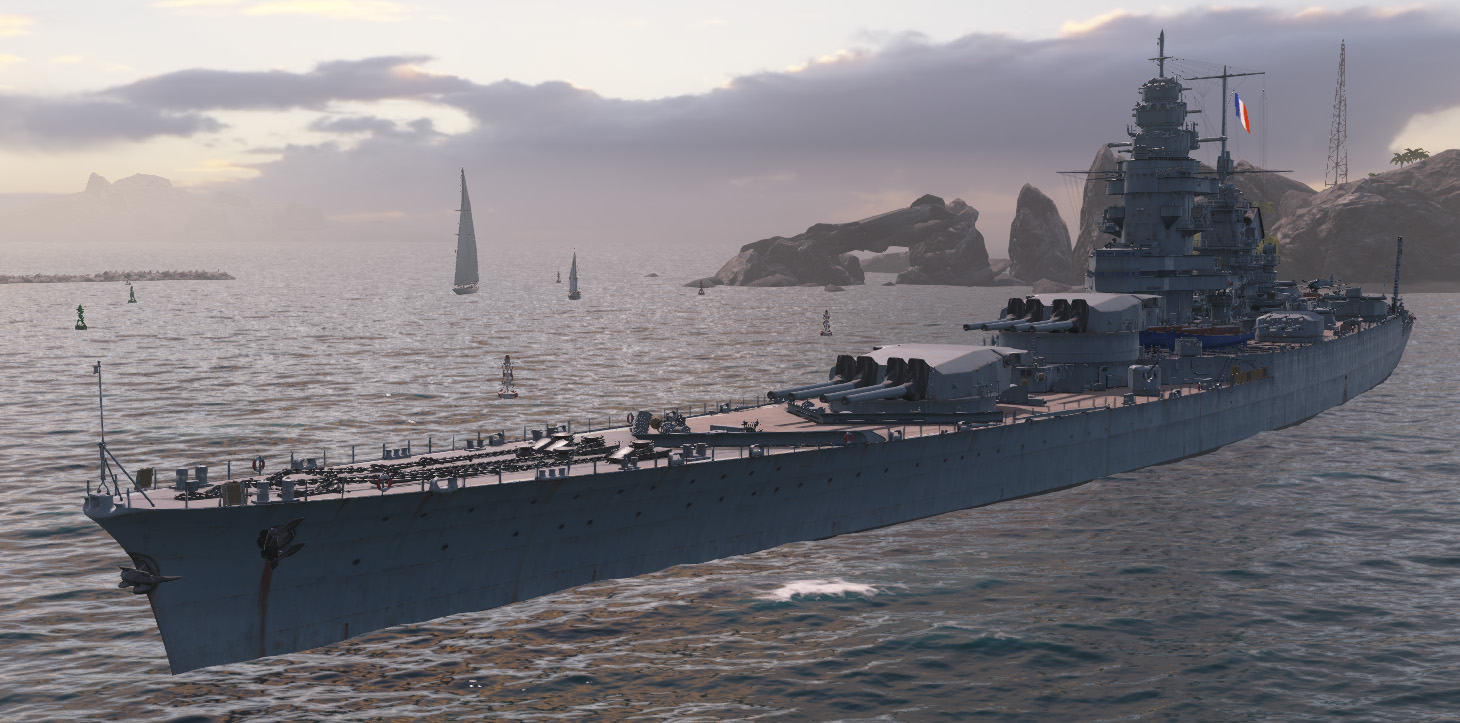
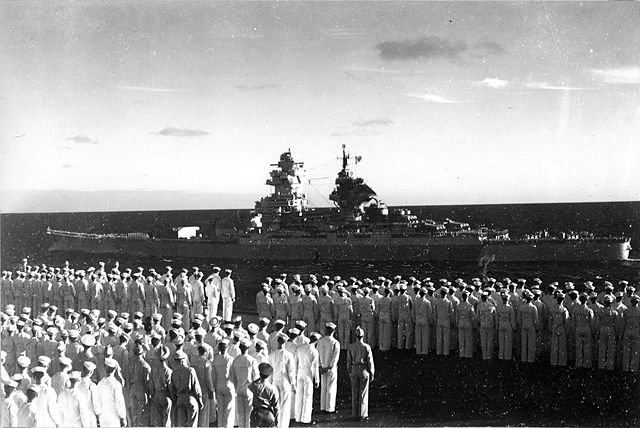
Richelieu as seen from USS Saratoga in May 1944, USN Photos, PD (cc)
After a some refittings in Durban, she set sail to Diego-Suarez, anchored there only to hear the announcement of the Japanese surrender. She then participated in the liberation of Singapore. A magnetic mine damaged her in the Strait of Malacca. After repairs in Singapore, she sailed back to Toulon to carry troops including marines to Indochina. Back in France 1946, she spent the rest of her life in squadron exercises, notably with the Jean Bart, her sister-ship finally freshly completed in 1956.
She was party refitted on this occasion, receiving new radars, new fire control systems, and modernized 381 mm mounts. Then she was placed in reserve in Brest in 1958, and stricken from the list in 1968. Under the name Q432, she was sent to Genoa to be broken up, although one of her salvaged guns is still visible nowadays on the Penfeld in Brest (NW France).
How fared the Richelieu compared to ther BBs ?
There’s now a famous study on WW2 top battleships on combinedfleet.com showing the rank of the Richelieu compared to other famous BBs like the Iowa, Yamato, Bismarck, KGV, South Dakota and Vitorrio Veneto. It shows the Richelieu in the middle, equal globally to the Bismarck on general rank and in several areas.
In terms of guns, both the Bismarck and Richelieu are on th same level, she’s superior in terms of armor, and on top of all BBs in terms of underwater protection. She’s also above in terms of fire control systems, but slightly below for tactical factors (speed, survivability, damage control …). For other factors taken in accounts, the final scores shows the Richelieu at 174, below the Iowa and South Dakota, but above the Bismarck, Yamato, KGV, and Veneto.

Closeup of the rear AAA after refit off NY, Sept/Oct.1943. U.S. Navy National Museum of Naval Aviation photo
The Jean Bart:
Second battleship of this class Richelieu, the unfortunate ship named after a famous Dunkirk corsair was launched March 6, 1940. Although work advanced well she was far from completed in June. She was therefore in Saint Nazaire when her captain, Briton Lieutenant Ronarc’h, decided to sail (with brand new engines that were never tested before, to Casablanca, Morocco. She was followed by a freighter carrying the second turret on board and all the remaining equipments, but the ship was sunk by a U-Boote en route.
She sank therefore with navigation equipment, fire control, AAA, a good part of electrical network and other equipment. So open arrival the ship was incomplete and far from completion in these circumtances. Nevertheless, the voyage has been a feat in itself, and a success. The ship anchored in Casablanca was from there protected by ASW nets and surrounded by AA batteries.
They were officially under the responsibility of the Vichy government. Completion work proceeded very slowly, with little equipment and manpower. During Operation Torch in November 1942, she was attacked by US Navy planes from the USS Ranger, and answered with salvos, duelling with the American battleship USS Massachusetts.
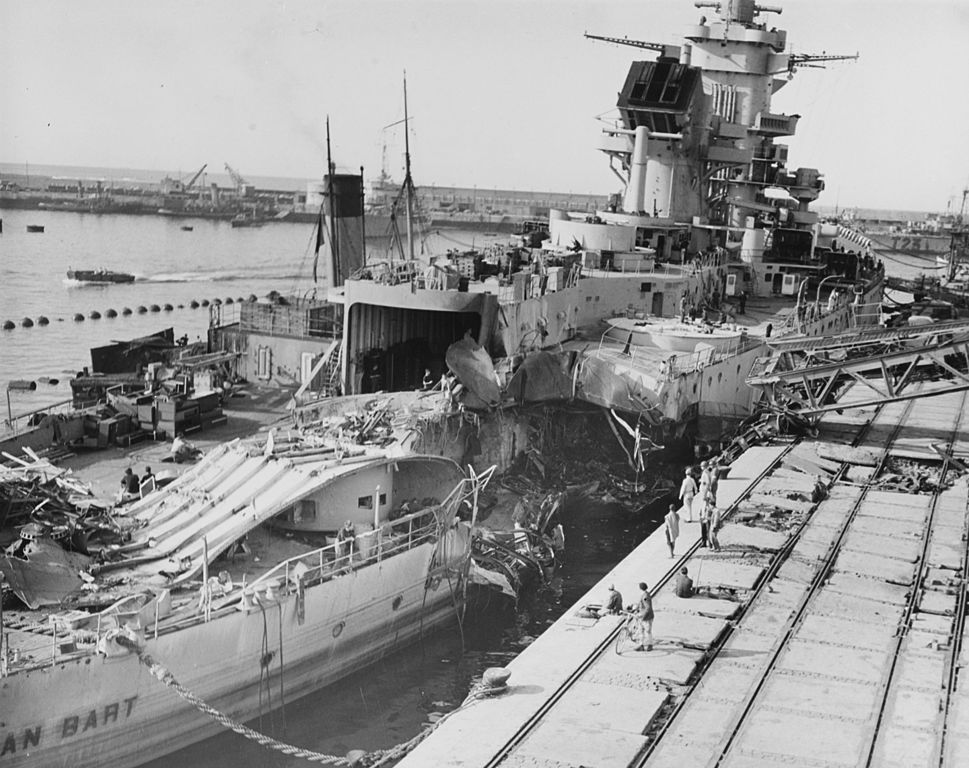
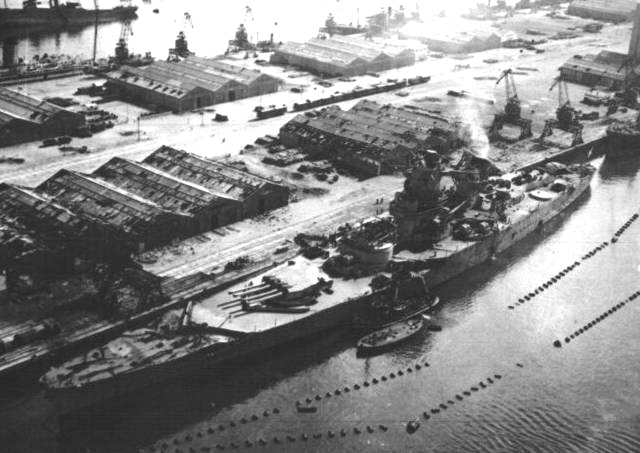
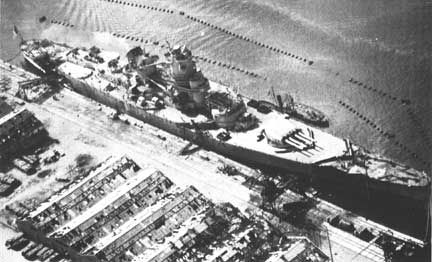
The Jean Bart at Casablanca, November 1942 during Operation Torch – USN aerial photos – PD cc
However she was soon hit by several 406 mm shells and aerial bombs. So as spotted by observation planes it was thought she had been silenced but on November 10, only two days later, the Jean Bart opened fire again, on the cruiser USS Augusta, at the big surprise of American landing forces nearby. She was struck by a vigorous new air raid from USS Ranger, hit hard this time, so as to sink in shallow waters, definitively out of action for the remainder of the war…
After the fleet swapped side to the allies, it was consider to repair her tenough to be sent to the USA for a completion to American standards, but this project never materialized. It was not until 1945 that the ship was towed back to Toulon, for a completion in 1949, but on completely design with modern AAA, better protection, completely redesigned electronic equipment. She was perhaps the most modern battleship so far, before the American Iowa were modernised in the late 1980s. Jean Bart potwar career, however, was short. During the Suez crisis she took part in the Franco-british landings cover operations he was withdrawn from service in 1961, broken up in 1968.
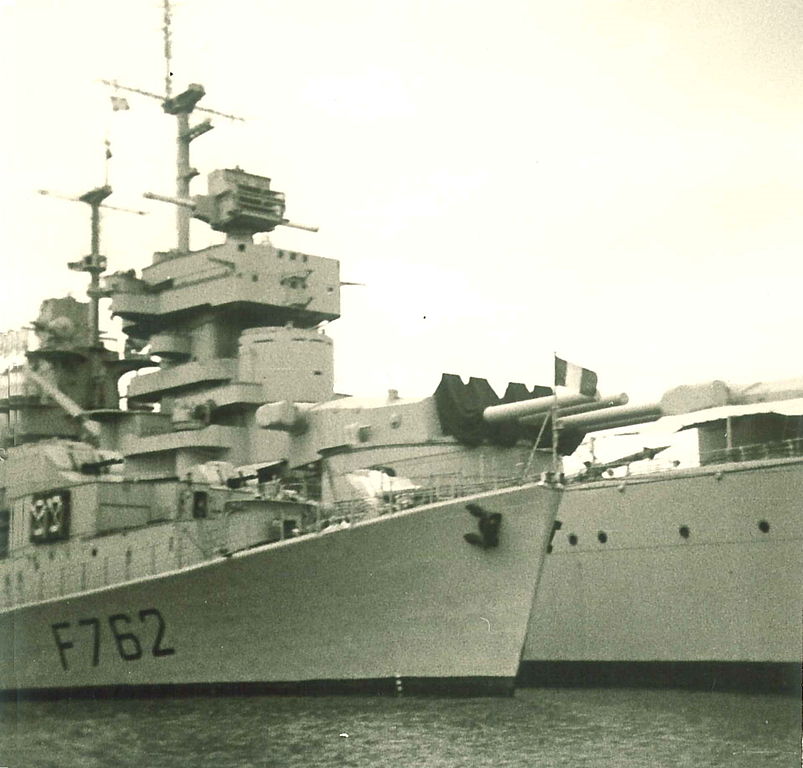
Battleship Jean Bart at Toulon, 1968, deactivated but showing her impressive 1950s refit
Last but not least
Similar in many ways but with turrets on both ends, the Gascogne class was started far too late. Clemenceau was laid down at Arsenal de Brest on 17 January 1939 and her hulk sunk in air attack, 27 August 1944. The Gascogne (after the Gascony region) was to be started at Chantiers de Penhoët, Saint-Nazaire but was cancelled due to German Invasion.
Characteristics
Displacement: 35,500 t. standard -48,950 t. Full Load
Dimensions: 248 m long, 35 m wide, 9.6 m draft.
Engines: 4 propellers, 4 Parsons turbines, 6 Indret boilers, 150,000 hp. Maximum speed 32 knots.
Armour: 225-280 mm belt, 30 mm anti-torpedo partitions, 115-137 bridge, 330-360 mm turrets, 330 mm bunker.
Armament: 8 pieces of 380 mm cal.45 (Model 1935), 9×135 mm DP (3×3), 8×100 mm AA (4×2), 12 pieces of 37 mm AA, 8 ML of 13.2 mm AA, 4 Loire 130 seaplanes.
Crew: 1380
Read More
en.wikipedia.org/wiki/Richelieu-class_battleship
More photos on maritime quest
More photos and timeline on museumconcept.com.hk

The Richelieu in Dakar in July 1940, with her weapons and equipment before refit. She will be completely refitted in 1943 and a quite unique camouflage pattern applied with blended waves of dark grey.




 Latest Facebook Entry -
Latest Facebook Entry -  X(Tweeter) Naval Encyclopedia's deck archive
X(Tweeter) Naval Encyclopedia's deck archive Instagram (@navalencyc)
Instagram (@navalencyc)





 French Navy
French Navy Royal Navy
Royal Navy Russian Navy
Russian Navy Armada Espanola
Armada Espanola Austrian Navy
Austrian Navy K.u.K. Kriegsmarine
K.u.K. Kriegsmarine Dansk Marine
Dansk Marine Nautiko Hellenon
Nautiko Hellenon Koninklije Marine 1870
Koninklije Marine 1870 Marinha do Brasil
Marinha do Brasil Osmanlı Donanması
Osmanlı Donanması Marina Do Peru
Marina Do Peru Marinha do Portugal
Marinha do Portugal Regia Marina 1870
Regia Marina 1870 Nihhon Kaigun 1870
Nihhon Kaigun 1870 Preußische Marine 1870
Preußische Marine 1870 Russkiy Flot 1870
Russkiy Flot 1870 Svenska marinen
Svenska marinen Søværnet
Søværnet Union Navy
Union Navy Confederate Navy
Confederate Navy Armada de Argentina
Armada de Argentina Imperial Chinese Navy
Imperial Chinese Navy Marinha do Portugal
Marinha do Portugal Mexico
Mexico Kaiserliche Marine
Kaiserliche Marine 1898 US Navy
1898 US Navy Sovietskiy Flot
Sovietskiy Flot Royal Canadian Navy
Royal Canadian Navy Royal Australian Navy
Royal Australian Navy RNZN Fleet
RNZN Fleet Chinese Navy 1937
Chinese Navy 1937 Kriegsmarine
Kriegsmarine Chilean Navy
Chilean Navy Danish Navy
Danish Navy Finnish Navy
Finnish Navy Hellenic Navy
Hellenic Navy Polish Navy
Polish Navy Romanian Navy
Romanian Navy Turkish Navy
Turkish Navy Royal Yugoslav Navy
Royal Yugoslav Navy Royal Thai Navy
Royal Thai Navy Minor Navies
Minor Navies Albania
Albania Austria
Austria Belgium
Belgium Columbia
Columbia Costa Rica
Costa Rica Cuba
Cuba Czechoslovakia
Czechoslovakia Dominican Republic
Dominican Republic Haiti
Haiti Hungary
Hungary Honduras
Honduras Estonia
Estonia Iceland
Iceland Eire
Eire Equador
Equador Iran
Iran Iraq
Iraq Latvia
Latvia Liberia
Liberia Lithuania
Lithuania Mandchukuo
Mandchukuo Morocco
Morocco Nicaragua
Nicaragua Persia
Persia San Salvador
San Salvador Sarawak
Sarawak Uruguay
Uruguay Venezuela
Venezuela Zanzibar
Zanzibar Warsaw Pact Navies
Warsaw Pact Navies Bulgaria
Bulgaria Hungary
Hungary

 Bundesmarine
Bundesmarine Dutch Navy
Dutch Navy Hellenic Navy
Hellenic Navy Marina Militare
Marina Militare Yugoslav Navy
Yugoslav Navy Chinese Navy
Chinese Navy Indian Navy
Indian Navy Indonesian Navy
Indonesian Navy JMSDF
JMSDF North Korean Navy
North Korean Navy Pakistani Navy
Pakistani Navy Philippines Navy
Philippines Navy ROKN
ROKN Rep. of Singapore Navy
Rep. of Singapore Navy Taiwanese Navy
Taiwanese Navy IDF Navy
IDF Navy Saudi Navy
Saudi Navy Royal New Zealand Navy
Royal New Zealand Navy Egyptian Navy
Egyptian Navy South African Navy
South African Navy






























 Ukrainian Navy
Ukrainian Navy dbodesign
dbodesign
These ships could have been very effective in combat but they didnt have much luck in real life. Same for the Dunkerque battleship
Not that much because of the lack of AA and radar, but on the paper both were great indeed. There is room for wannabe whatif storytellers 😉
Yeah true just saying these ships could have done alot more than they had, they were at the wrong place at the wrong time i guess.
These ships were a one trick pony. – offense!
8 guns available under ideal conditions, but none available under withdrawal. Any reasonably sized ship pursuing this class would only face 6 inch (155mm) guns. Not very intimidating.
you mean 9 dude did you see the buildpapers ? deepest anti sub defense system full 90• degree reload capability with all guns it was the first of all battleships in that time and even years later there was no one with that capability 32knots top speed heavy armor much space on deck just way better than all of the battleships out there I love naval history and technology and this was a realy nice ship